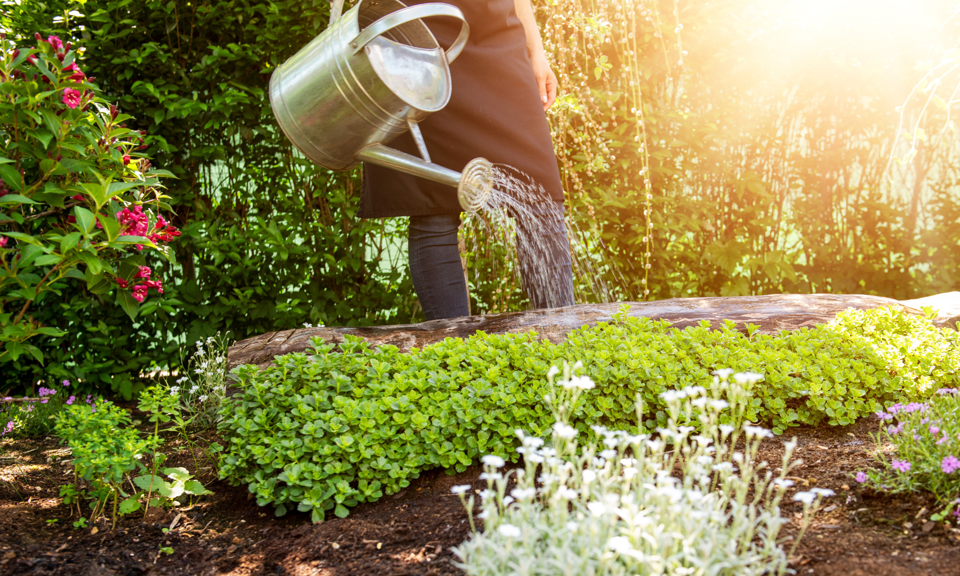HTA Offers Guidance for Growers, Gardeners, and Wildlife During Spells of Hot, Dry Weather

7 July 2023
Following the official confirmation by the Met Office of June 2023 as the hottest June on record, the Horticultural Trades Association (HTA) is reaffirming its commitment to supporting its members in managing water usage as well as emphasising its key asks of policymakers in looking at water resilience measures. There is also advice via the Association of Professional Landscapers (APL) for consumers tending to newly landscaped gardens. In recognition of the collective effort required to use water responsibly, the HTA also shares valuable tips for individuals and encourages them to consult local garden centre experts for further guidance.
Enhancing Biodiversity:
- Building a Small Wildlife Pond:
Creating a wildlife pond need not be complicated or expensive. It can start with something as simple as a bowl of water, but for a more attractive option for wildlife, dig a hole (as obvious as it sounds!). An affordable option is using a small tank of tough, rigid, thick polythene that ensures a healthy pond ecosystem by resisting punctures. When selecting a location, avoid areas with overhanging trees that can cause challenges with leaf fall in autumn. Plant a variety of pond plants like watercress, greater spearwort, water mint, hornwort, and water starwort to provide habitats and maintain water clarity. Regular maintenance, such as cutting and removing overgrown plants, is crucial for a thriving ecosystem.
- Promoting Bee Diversity:
While honeybees are renowned pollinators, it's important to appreciate the significant role of other bee species, including bumblebees (24 species) and solitary bees (nearly 250 species). To create an inviting habitat, heap soil in a sunny space or clear plants from an existing bank. Ensure the area faces south and provide nearby food sources such as spring bulbs (narcissus, tulip, hyacinth) and early wildflowers (dandelions, primroses, violets, flowering currant, fruit trees). These simple steps can encourage various bee species to thrive in your garden.
- Building Bug Hotels:
Bug hotels offer shelter and nesting opportunities for a range of beneficial insects. Instead of purchasing ready-made bug hotels, you can create your own by setting logs or old fence posts into the ground and drilling holes of varying sizes (5mm to 10mm diameter, 80mm deep) at about 1m-1.5m above ground level. Alternatively, bundles of hollow reeds or canes can serve the same purpose, providing nesting habitats for solitary bees like carpenter and mason bees, thereby contributing to garden biodiversity.
- Creating Hedgehog Habitats:
Hedgehogs play a crucial role in pest control and make charming additions to any garden. Construct a hedgehog hut in a quiet corner of your garden using sturdy materials, ensuring an entrance for the hedgehogs. Cover the framework with foliage, branches, and shrubbery to create a dark and cosy space for these nocturnal creatures. Fill the hut with leaves and shrubbery, and provide sustenance by leaving food like beetles, earwigs, worms, or meaty cat and dog food (avoid mealworms and milk).
- Hedgehog Feeding Station:
Supporting hedgehogs can be further accomplished by setting up a feeding station. Turn a plastic storage box upside down or place the lid on the box, cutting a hole approximately 10cm x 10cm in the short end and securing it with tape. Line the box with plenty of newspaper to manage any mess, and place the food at the opposite end of the hole to prevent access by foxes or cats. Secure the box with a brick to prevent movement or lid displacement.
Watering Tips
Effective watering techniques are crucial for maintaining healthy plants during hot weather. As part of the HTA's 'Get Summer Colour' social media campaign running throughout July and August, the following tips will be shared alongside other valuable advice:
- Opt for thorough watering sessions rather than frequent light watering to ensure water reaches the plant's root zone effectively while conserving water.
- If potted plants have dried out and the soil has shrunk, try plunging them in shallow trays of water for a couple of hours to help them gradually rehydrate.
- When watering and feeding hanging baskets or wall troughs, place a patio pot or planter beneath to catch excess water and feed, enabling the pot below to benefit from the runoff.
Vibrant flowers not only bring joy to gardeners but also attract butterflies, bees, and other pollinators. By adapting gardening techniques and creating a welcoming environment for wildlife, individuals can play a vital role in supporting the UK's environment and preserving biodiversity.
Pippa Greenwood, HTA Horticulture Manager, commented:
“We know that climate change is increasing the frequency and intensity of warm weather events, so we must do everything we can to help our members continue to produce and nurture the plants and trees that are so crucial to the UK’s environment but also to help the public on ways they can adapt their gardens and gardening techniques to ensure their green spaces can thrive as well as support our wildlife.”
Further guides on building ponds and attracting wildlife to gardens will be available on the Association of Professional Landscapers website in the coming weeks www.landscaper.org.uk

